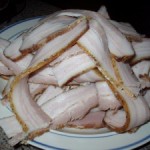When you think of where surfboards made, you probably think of workshops and factories in surfing Meccas like California, Hawaii and Australia (OK, maybe China too, but that’s another story).
The last place you would think of would be a small landlocked city like Guelph, Ontario. That’s where a transplanted American named Michael Waters handcrafts old-school surfboards made of red cedar, white pine and mahogany.
So how did man with a last name like Waters end up making surfboards in a farming town known for its veterinary school, Mennonite population and Sleeman beer factory? It’s an interesting tale that began in California.
Waters grew up a quintessential California surfer. He lived in the Hollywood area in the late 50’s and early 60’s and spent his youth hitchhiking up and down the Pacific coast surfing in places like Malibu, Ventura County, San Diego and Mexico.
Waters was admittedly a wild kid, and after a couple of years of high school, his parents had had enough. They punished him by sending him to Hawaii to finish high school.
“I was a troublesome child and my parents said, ‘How would you like to go to Hawaii?’ I think that was on a Monday, and I was in Hawaii by Sunday,” he said.
Waters spent the next few years in…well, the water. He lived near Honolulu on the island of Oahu where bodysurfed at Makapu’u, slept on the beach and surfed at Waikiki, and spearfished in Haunama Bay.
“I almost drowned many times in Hawaii,” he said.
In order to avoid the draft and end up as canon fodder in the Marines, Waters enlisted in the Navy and had “a four-year vacation” in Vietnam where he was a member of the United States Seventh Fleet, also known as the Tonkin Gulf Yacht Club.
Upon returning, Waters sowed his wild oats as a private investigator, ending up in Prince Rupert in Northern B.C. near the Alaskan border. He eventually made his way to Toronto to work in the movie business. That’s where would meet his wife, a Canadian from the Guelph area.
While working 80 hours a week, Waters started to hear the seductive call of the ocean, and it wasn’t long before he was back in Hawaii with his wife and son. While taking a computer-related job in the military, Waters began to make surfboards on the side.
In his youth, Waters had experimented making foam boards, but this time he decided to make boards with wood.
“I like working with wood for two reasons; one it is good for the environment and leaves a smaller footprint on the ecosystem and two, these boards are more durable, pleasant to look at and safer to make, since there is little toxic material contact.”
After a few years back in Hawaii, Waters’ son decided he wanted to attend the University of Toronto. So the family packed up and headed back to Ontario. This time, Waters and his wife settled in Guelph.
Waters continued to make wooden surfboards, and about three years ago he decided to turn his hobby into a small business.
“The boards are well well received but a lot people are still pretty much into the foam mentality,” he said.
Waters figures in time people will be drawn to the eco-friendly aspects of his boards as well as their durability. Waters is also trying appeal to surfers by keeping his prices competitive.

Waters' Hawaiian-style fun board
“I’m trying to make it reasonable; $600 for a shortboard. and about $1,200 for a longboard,” he said.
Waters customizes each board according to the surfer. You can see some examples of his boards at: canadianwaters.ca.
“To get a board made all you have to do is contact me and let me know a few things about your current boards you ride, what you like, what you don’t like and send me a deposit and I will keep you posted on the progress of the board.”
It takes Waters about six to eight weeks to craft a vessel.
“They have a hollow, rib and stringer construction. Since the boards are made from the inside out – frame, ribs and planks – the planning is much more detailed than foam shaping.”
Although landlocked, Waters still tries to get out surfing on occasion. Because he’s so far from the ocean, Waters has had to resort to surfing on the Great Lakes and river rapids. Recently, he was in Sheboygan, Wisconsin for the Dairyland Surf Classic.
Located on Lake Michigan, the Dairyland Surf Classic is the largest lake surfing competition in the world. At the Classic, Waters met Lee and Larry Williams, the founders of the contest who were featured in the movie Step into Liquid.
In something Nova Scotia surfers can all relate to this fall, there was no surf on Lake Michigan for the Classic. As a result, Waters ended up competing in a paddling contest. He also helped keep spirits up by sharing his homemade pineapple wine with other surfers.
For his next trip, Waters is hoping to make it out to Nova Scotia.
“I’d like to come before Christmas,” he said. “I’m working on a board that would be perfect for a point break.”



